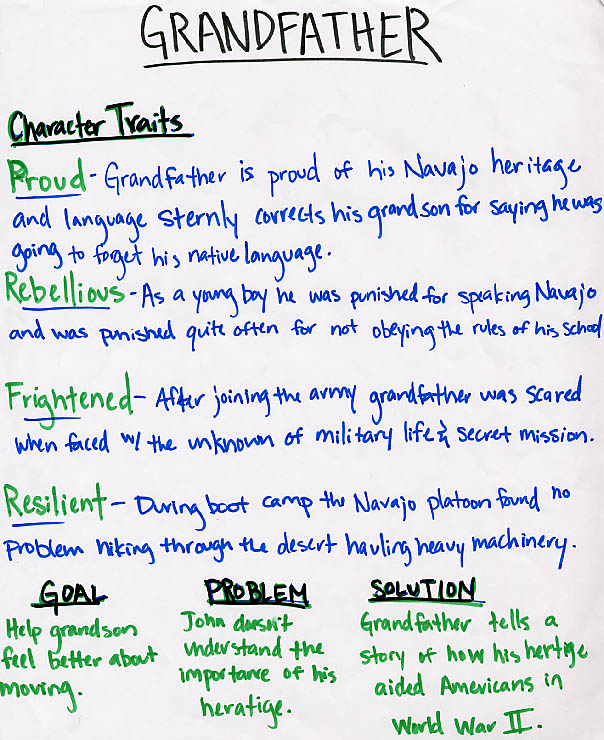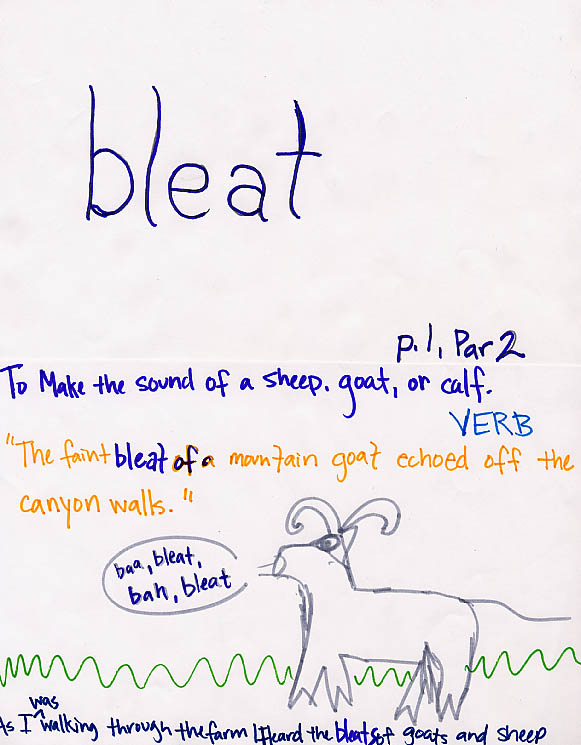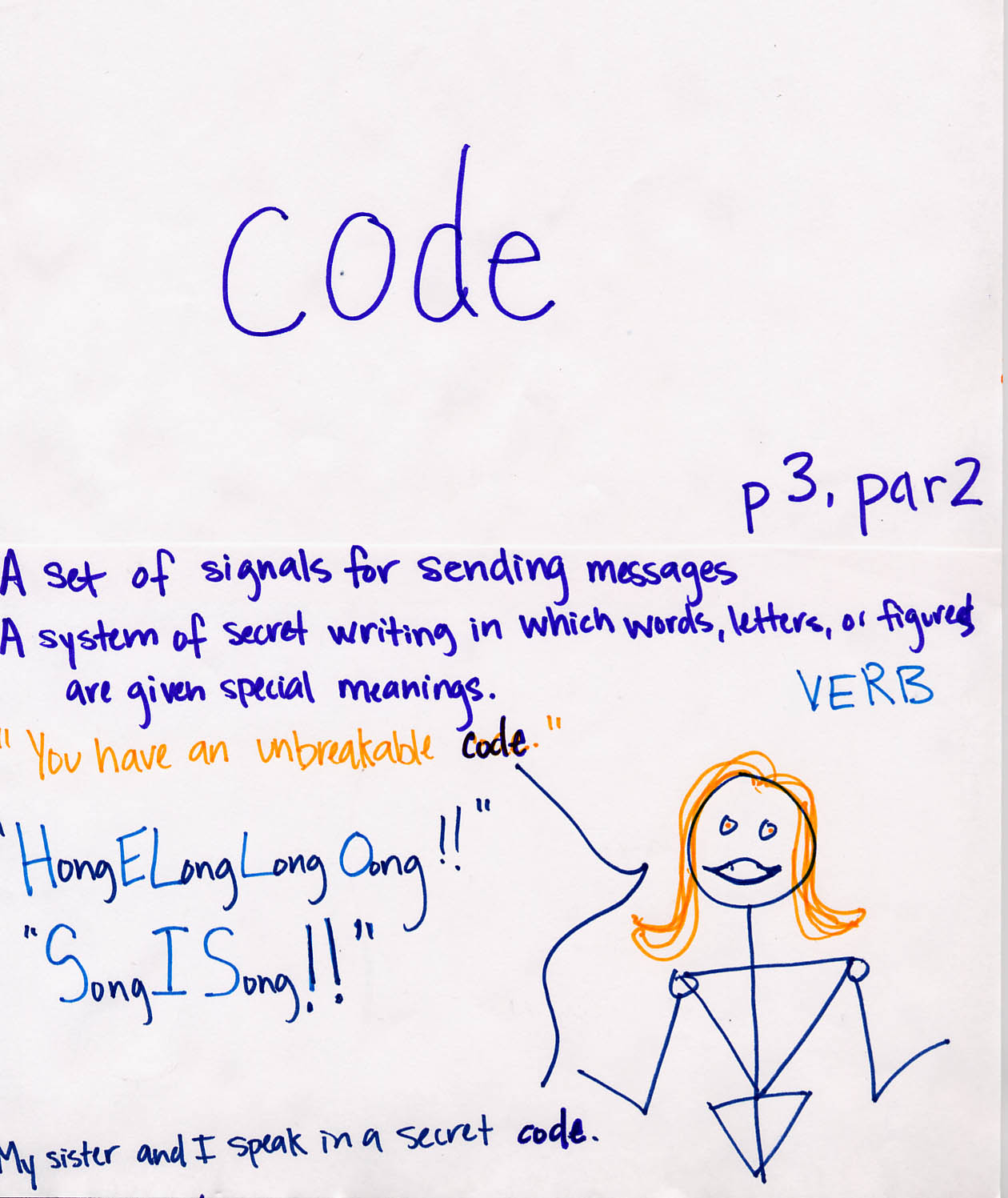by: Sara Hoagland Hunter
illustrations: Julia Miner
Section 1 p.1-13

|
by: Sara Hoagland Hunter illustrations: Julia Miner Section 1 p.1-13 |
 |
Character Sketcher
Your job today as character sketcher is
to create and illustrate a character map of a character. You are
to use at least three words that describe grandfather. For each word,
or character trait, you will prove or give an example from the text.
You will also identify the character goals, problem and solution (or possible
solution) for that section of reading. Finally, you will make a visual
illustration of your character.
| Grandfather
Character Traits: Proud (p. 3, par. 4) Grandfather is proud of his Navajo heritage and language sternly corrects his grandson for saying he was going to forget his native language. Rebellious (p. 4, par. 1) Grandfather as a young boy was punished for speaking Navajo and was punished quite often for not obeying the rules of his school. Frightened (p. 5, par. 2) After joining the army grandfather was scared when faced with the unknown of military life and secret mission. Resilient (p. 6, par. 1) During boot camp the Navajo platoon found no problem hiking through the desert, and hauling heavy machinery. Goal: To help his grandson feel better about
moving.
|
 |
Passage Picker
Today your job is to find 4 passages in
the text that are significant and/or descriptive and lead the group into
discussion through questioning and stating the author's purpose for the
passage. Follow the steps below:
1. Pick out a passage
you would like to share.
2. Write down the page
and paragraph number.
3. Write down the first
two words and the last two words of your passage.
4. Write down the reason
you chose the passage, and explain why
5. Ask a question about
your passage, and give an answer.
6. Write down the Authors
Purpose: To Describe, To Entertain, To Inform, or To Persuade.
Look for passages that are:
Descriptive Informative and Entertaining
1- Passage #1
2- p. 3, par. 1
3- "Grandfather's soft...ever seen."
4- I choose this passage because it is
good physical description as well as an implicit description of his presence.
5- Q: What dose this passage tell
you about John's view of his grandfather?
A: The presence
of Grandfather makes John feel comfortable, and views his grandfather as
a friend.
6- To Describe
1- Passage #2
2- p. 4, par. 1
3- "They gave...never forget."
4- Shows that Grandfather was a bit rebellious
and proud because he would rather be punished than forget his native language.
5- Q: If you went to school another
country that spoke a different language and when you would speak your native
language they make you suck on soap do you think that you would still speak
your native language?
A: I think
that putting soap in a person's mouth is not a good way of getting them
to want to learn a new language because it does not help the student it
only hurts them. I think if it was me I would get so stressed with
trying not to speak my native language that I would not speak at all.
6- To inform
1- Passage #3
2- p. 4, par. 4
3- "Just before...I enlisted"
4- It is a beautiful simile of how grandfather
felt when he knew he was going to leave the government school.
5- Q: Why do you think that the author
used a "wild horse with a lasso finally off his neck" to describe grandfather?
A: The horse
is relevant to grandfather and his life. A horse is an animal that
he would have been around to see. It would not fit in the story if
grandfather had referred to a camel or some animal that is not used in
the United States. The passage also describes grandfather feeling
of leaving the school and being free.
6- To describe
1- Passage #4
2- p. 7, par. 3
3- "When the...the country."
4- To show how the government's view of
the Navajo language changed when it helps Americans in war.
5- Q: Why is Grandfather laughing when
he finds out that they are going to use Navajo language as a code for war?
A: Because when
he was a child he was punished for using Navajo and now is is going to
save the country.
6- To entertain
Word Wizard
Your job today is to find 4 words that
are essential to the meaning of the story, or other unknown words.
Follow these steps when recording your words:
1- Word page and paragraph #
2- Sentence used in text.
3- Definition
4- Part of Speech
5- Your own sentence using the word.
With 2 of these four words you will put
on a note card:
On the Front:
Word
(page # and paragraph # in corner)
On the Back:
Define
Part of speech
The sentence the with word from the text
Your own sentence using the word
Illustrate the word.
| 1- bleat p1, par 2
2- "The faint bleat of a mountain goat echoed off the canyon walls." 3- to make the sound of a goat, sheep, or calf. 4- verb 5- As I was walking through the farm I heard the bleats of goats and sheep. |
 |
1- ceremonies p 12, par 1
2- "I just stayed on the deck of the ship
thinking about the ceremonies they were doing for me at home."
3- an act or set of acts done in
a particular way to celebrate a special occasion.
4- noun
5- They are having a ceremony to
honor my visit.
| 1- code p 3, par 2
2- "You have an unbreakable code." 3- a set of signals for sending messages. A system of secret writing in which words, letters, or figures are given special meanings. 4- noun 5- My sister and I speak in a secret code so no one else will understand. |
 |
Discussion Director
Your job today is to generate 5 meaningful
questions and answers that will motivate group discussion. You will
want to use different types of questions like: Fact & Opinion, Multiple
Choice End of Grade, Problem/Solution, Sequence, Prediction, Cause &
Effect. Good Questions begin with: Who, What, When, Where, Why, How,
Tell, and Describe.
Each question must have a page# and paragragh#
of where the answer can be found in the text.
1. Q: Why did the US Government think that
the Navajo language would be good for code?
A: Because it was not
a written language so the Japanese would not be able to decode a language
with no alphabet.
(p. 6, par. 1)
2. Q: Why did grandfather "not want to touch"
his family with stories of fighting in the war?
A: Because grandfather
is not proud that he had to fight, he doesn't seem to be the kind of man
that would be proud of hurting or killing people. (p. 4, par. 2)
3. Q: What does the author mean by using
"blood red" as a decryption of the creek during the battle?
A: That so many people
died that their blood was running through the creek really making it red
as blood. (p.13 par. 3)
4. Native Americans were not allowed to
fight in War for the United States.
TRUE/FALSE
A:False
5. Navajo's are good with radios and that
is why the government wanted them in the military.
FACT/OPINION
A:Opinion
Travel Tracer
Your job is to create a map of the travels
that Grandfather made.